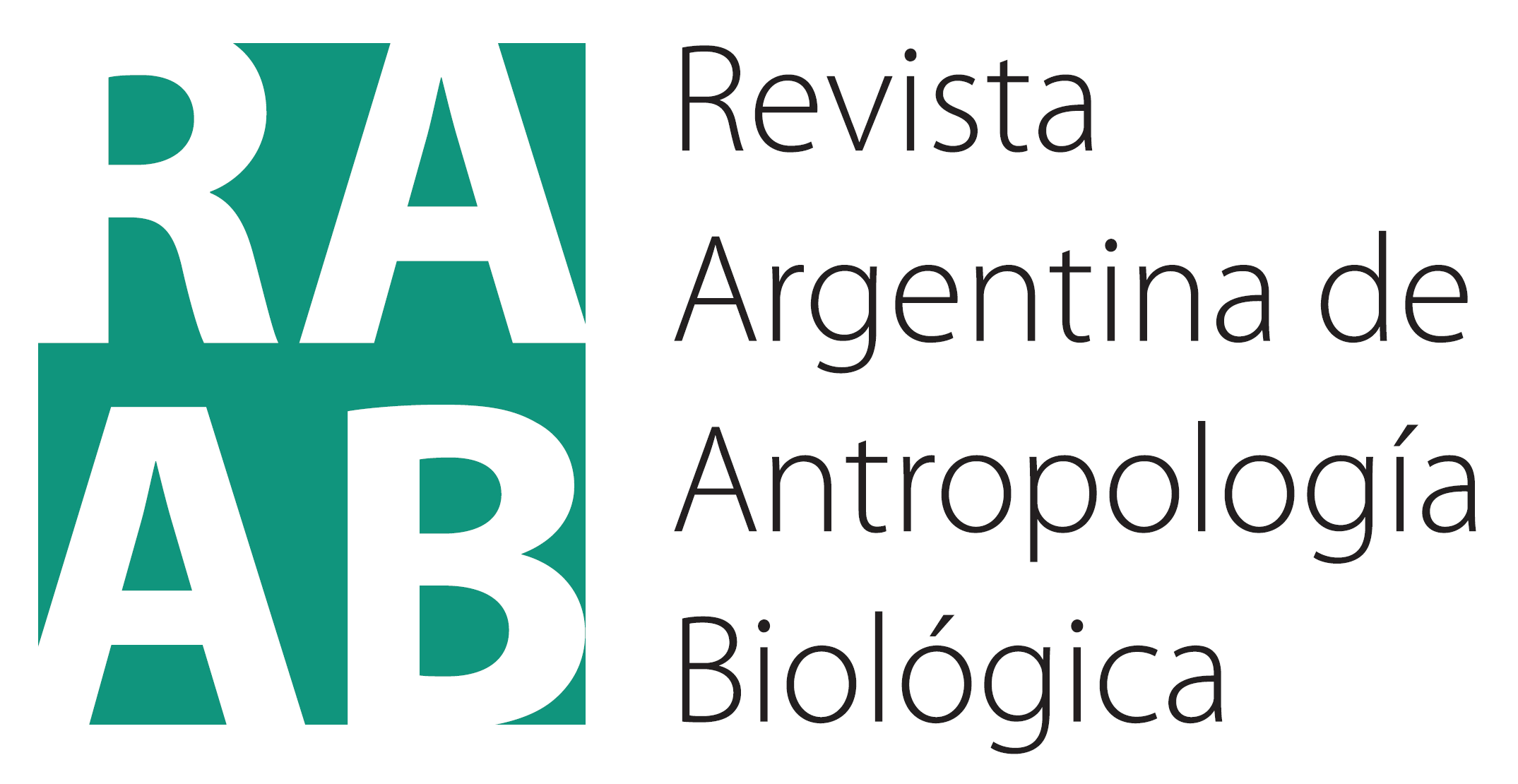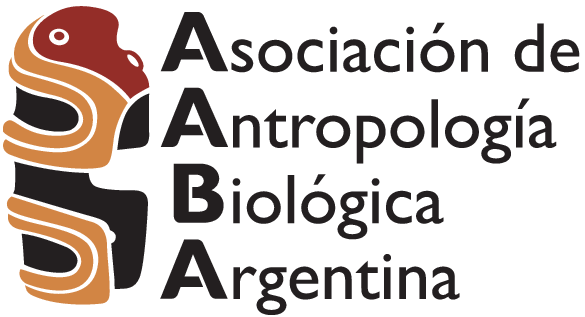Nasal fracture and interpersonal violence in continental Southern Patagonia during the Late Holocene
DOI:
https://doi.org/10.24215/18536387e077Keywords:
blunt force trauma, facial fracture, hunter-gatherers, lateral impact force, skullAbstract
Nasal fracture is the most common type of facial fracture in modern populations and is usually related to interpersonal violence. Nevertheless, this type of injury has been scarcely studied in bioanthropological field. In this study, it was characterized and discussed the oldest known Southern Patagonia individual presenting nasal fracture, among other lesions, most probably resulting from interpersonal violence. We reanalysed the individual 2 from Orejas de Burro 1 site dated from Late Holocene, the nasal fossae and other skull bones to study nasal fractures using a recent method developed by Magalhães et al. (2020). Orejas de Burro 1 -2- presented nine fractures, four of them in the nasal area and showing different timing: one postmortem, two perimortem, and one antemortem. The other facial lesions consisted of four diastatic fractures and one in the fragile septum. The individual presented a high-energy injury resulting in intense bone disruption and displacement of nasal and facial bones produced by a lateral blow, which may be related to an episode of interpersonal violence. While some likely options are regionally known, it is highly difficult to assess the cause of the injury and the blunt object associated with this episode since there is a situation of equifinality. This is the oldest known record case reported of a nasal fracture in Southern Patagonia and one of the oldest of South America. Also, it is the early evidence of traumatic injury, possibly due to an episode of interpersonal violence.
Downloads
Metrics
References
Alfonso-Durruty, M. P., Palacios, C., & Morello, F. (2021). Haunting bodies: lethal violence in three LateHolocene precontact hunter-gatherers from southernmost Fuego-Patagonia (52°–56°S, Chile). Bioarchaeology International, 5(1-2), 68-77. http://doi.org/10.5744/bi.2021.1003
Aspillaga, E., Ocampo, C. E., & Rivas, H. P. (1999). Restos óseos humanos en contextos arqueológicos del área de Isla de Navarino: indicadores de estilos de vida en indígenas canoeros. Anales del Instituto de la Patagonia, serie Ciencias Humanas, 27, 123-135.
Barrientos, G., & Gordón F. (2004). Explorando la relación entre nucleamiento poblacional y violencia interpersonal durante el Holoceno tardío en el noreste de Patagonia (República Argentina). Magallania, 32, 53‐69.
Borrero, L. A. (1994-95). Arqueología de la Patagonia. Palimpsesto, 4, 9-69.
Borrero, L. A. (2001). El poblamiento de Patagonia. Toldos, milodones y volcanes. Emecé Editores.
Brickley, M., & Smith, M. (2006). Culturally determined patterns of violence: biological anthropological investigations at a historic urban cemetery. American Anthropologist, 108(1), 163–177. http://doi.org/10.1525/aa.2006.108.1.163
Chan, J., & Most, S.P. (2008). Diagnosis and management of nasal fractures. Operative Techniques in Otolaryngology-Head and Neck Surgery, 19(4), 263–266. http://doi.org/10.1016/j.otot.2008.07.003
Chapman, A. (1989). El fin de un mundo: los Selk’nam de Tierra del Fuego. Vázquez Mazzini Editores.
Constantinescu, F. (2001). Canal Maule y Punta Santa Ana: el habitus cazador recolector marítimo femenino (patrones óseos característicos del modo de vida canoero en el extremo sur de Chile). Anales del Instituto de la Patagonia, 29, 163-181.
Constantinescu, F. (2003). Obsidiana verde incrustada en un cráneo Aónikenk: ¿tensión social intraétnica o interétnica? We’ll never know! Magallania, 31, 149‐153.
D’Angelo del Campo, M. D., Curti, H., López, M. G., García Laborde, P., Valenzuela, L. O., Martucci, M., Motti, J. M. B., Palacio, P., González Martín, A., & Guichón, R. A. (2020). Base de Información Bioantropológica de Patagonia Austral (B.I.B.P.A.). Revista Argentina de Antropología Biológica, 22(2), 018. https://doi.org/10.24215/18536387e057
Djurić, M. P., Roberts, C. A., Rakočević, Z. B., Djonić, D. D., & Lešić, A. R. (2006). Fractures in late medieval skeletal populations from Serbia. American Journal of Physical Anthropology, 130(2), 167–178. http://doi.org/10.1002/ajpa.20270
Faurie, C., & Raymond, M. (2004). Handedness frequency over more than ten thousand years. Proceedings of the Royal Society, Biological Sciences, 271(3), S43–45. http://doi.org/10.1098/rsbl.2003.0092
Flensborg, G. (2011). Lesiones traumáticas en cráneos del sitio Paso Alsina 1. Explorando indicadores de violencia interpersonal en la transición Pampeano-Patagónica Oriental (Argentina). InterSecciones en Antropología, 12, 45-59.
Flensborg, G., & Suby, J. A. (2020). Trauma y violencia en Patagonia Austral. Interpretación de evidencias bioarqueológicas y perspectivas futuras. Chungara Revista de Antropología Chilena, 52(1), 41- 55. http://doi.org/10.4067/S0717-73562020005000101
Fugassa, M., & Barberena, R. (2006). Cuevas y zoonosis antiguas: paleopatología del sitio Orejas de Burro 1 (Santa Cruz, Argentina). Magallania, 34(2), 57-62. http://doi.org/10.4067/S0718-22442006000200006
Fraioli, R. E., Branstetter, B. F., & Deleyiannis, F. W. B. (2008). Facial fractures: beyond Le Fort. Otolaryngologic Clinics of North America, 41(1), 51–76. http://doi.org/10.1016/j.otc.2007.10.003
Franco, N. V. (2004). La organización tecnológica y el uso de escalas espaciales amplias. El caso del sur y oeste de Lago Argentino. In A. Acosta, D. Loponte, & M. Ramos (Eds.), Temas de Arqueología, Análisis Lítico (pp. 101-144). Universidad Nacional de Luján.
Franco, N. V., Brook, G. A., García Guraieb, S., Mancini, M. V., Guarido, A. L, Mehl, A., & Montenegro, T. (2017). Reuse of burial sites during the Late Holocene: evidence from multiple human burials at the Río Bote 1 rock shelter, Upper Santa Cruz River Basin (Southern Patagonia, Argentina). Latin American Antiquity, 28(4), 476-494. http://doi.org/10.1017/laq.2017.35
Galloway, A., & Wedel, V. L. (2014). Bones of the skull, the dentition, and osseous structures of the throat. In Wedel, V.L., & Galloway, A. (Eds.). Broken Bones. Anthropological Analysis of Blunt Force Trauma (2nd ed., pp. 133–160). Charles C. Thomas, Publisher.
García Guraieb, S. R., Goñi, R., & Bosio, L. (2007). Lesiones traumáticas en un entierro del lago Salitroso (Santa Cruz, Argentina). In Flavia Morello, Alfredo Prieto & Gabriel Bahamonde (Eds.), Arqueología de Fuego‐Patagonia: levantando piedras, desenterrando huesos – y develando arcanos [Sextas Jornadas de Arqueología de la Patagonia, Punta Arenas, 24 al 28 de Octubre de 2005] (pp. 375‐380). Ediciones CEQUA.
García Guraieb, S. R. (2010). Bioarqueología de Cazadores-Recolectores del Holoceno Tardío de la Cuenca del Lago Salitroso (Santa Cruz): Aspectos Paleodemográficos y Paleopatológicos. [Master’s thesis, Faculty of Philosophy and Letters, National University of Buenos Aires]. http://repositorio.filo.uba.ar/handle/filodigital/1655
Gómez Otero, J., & Dahinten, S. (1997/1998). Costumbres funerarias y esqueletos humanos: variabilidad y poblamiento en la costa nordeste de la provincia de Chubut (Patagonia Argentina). Relaciones de la Sociedad Argentina de Antropología, XXII-XXIII, 101‐124.
González, R. A. (1953). La boleadora. Sus áreas de dispersión y tipos. Revista del Museo de la Universidad Nacional de la Plata. Nueva Serie. Sección Antropología, 4(21), 133-292.
Gordón, F. (2009). Tafonomía humana y lesiones traumáticas en colecciones de museos. Evaluación de cráneos del noreste de Patagonia. InterSecciones en Antropología, 10(1), 27‐41.
Gordón, F. (2011). Dinámica poblacional, conflicto y violencia en el Norte de Patagonia durante el Holoceno tardío: un estudio arqueológico. [Master’s thesis, Faculty of Natural Sciences and Museum, National University of La Plata, Buenos Aires, Argentina]. http://sedici.unlp.edu.ar/handle/10915/519312
Gordón, F. (2015). Bioarchaeological patterns of violence in North Patagonia (Argentina) during the late Holocene. Implications for the study of population dynamics. International Journal of Osteoarchaeology, 25(5), 625-636. http://doi.org/10.1002/oa.2325
Gordón, F., & Bosio, L. A. (2012). An experimental approach to the study of interpersonal violence in Northeastern Patagonia (Argentina), during the late Holocene. Journal of Archaeological Science, 39(3), 640-647. http://doi.org/10.1016/j.jas.2011.10.023
Guichón, R. A., Barberena, R., & Borrero, L. A. (2001). ¿Dónde y cómo aparecen los restos óseos humanos en Patagonia Austral? Anales del Instituto de la Patagonia, Serie Ciencias Humanas, 29, 103-118.
Gusinde, M. (1982 [1939]). Los indios de Tierra del Fuego, Tomo 1: Los Selk´nam (1st ed., Vol. 1). Centro Argentino de Etnología Americana.
Gusinde, M. (1951). Fueguinos. Hombres primitivos en la Tierra del Fuego: de investigador a compañero de tribu. CSIC - Escuela de Estudios Hispano-Americanos (EEHA).
Han, D. S. Y., Han, Y. S., & Park, J. H. (2011). A new approach to the treatment of nasal bone fracture: radiologic classification of nasal bone fractures and its clinical application. Journal of Oral and Maxillofacial Surgery, 69(11), 2841–2847. http://doi.org/10.1016/j.joms.2011.01.013
Kelly, R. C. (1996). War before civilization: the myth of the peaceful savage (1st ed.). Oxford University Press.
Kelly, R. C. (2000). Warless societies and the origins of war. University of Michigan Press.
Krakowka, K. (2017). Violence-related trauma from the Cistercian Abbey of St Mary Graces and a late black death cemetery. International Journal of Osteoarchaeology, 27(1), 56–66. http://doi.org/10.1002/oa.2462
Kranioti, E. F. (2015). Forensic investigation of cranial injuries due to blunt force trauma: current best practice. Research and Reports in Forensic Medical Science, 5, 25-37. http://doi.org/10.2147/RRFMS.S70423
L’Heureux, G. L., & Barberena, R. (2008). Evidencias bioarqueológicas en Patagonia meridional: el sitio Orejas de Burro 1 (Pali Aike, provincia de Santa Cruz). InterSecciones en Antropología, 9, 11-24.
L’Heureux, G. L., & Amorosi, T. (2009). El entierro 2 del sitio Cañadón Leona 5 (Región de Magallanes, Chile). Viejos huesos, nuevos datos. Magallania, 37(2), 41‐55. http://doi.org/10.4067/S0718-22442009000200003
L’Heureux, G. L., & Amorosi, T. (2010). El entierro del sitio Cerro Sota (Magallanes, Chile) a más de setenta años de su excavación. Magallania, 38(2), 133-149. http://doi.org/10.4067/S0718-22442010000200009
Magalhães,B. M., Mays, S.,&Santos, A. L. (2020). A new approach to recording nasal fracture in skeletonized individuals. International Journal of Paleopathology, 30, 105-109. http://doi.org/10.1016/j.ijpp.2020.04.003
Magalhães, B. M., Mays, S., Stark, S., & Santos, A. L. (2023). A biocultural study of nasal fracture, violence, and gender using 19th-20th century skeletal remains from Portugal. International Journal of Osteoarchaeology, 33(5), 858-867. http://doi.org/10.1002/oa.3233
Mendonça, O. J., Aguerre, A., Bordach, M., Ammann, M., Arrieta, M., Croatto, M., & Pera, L. (2010). Inclusiones funerarias y dimensiones sociales del comportamiento mortuorio en el médano petroquímica, Depto. Puelén, Provincia de La Pampa. In M. Berón, L. Luna, M. Bonomo, C. Montalvo, C. Aranda, & M. Carrera Aizpitarte (Eds.), Mamül Mapu: pasado y presente desde la arqueología pampeana (pp. 215-222). Libros del Espinillo.
Morello, F., Torres, J., Martínez, I., Rodriguez, K., Arroyo-Kalin, M., French, C., Sierpe, V., & San Román, M. (2012). Arqueología de la Punta Santa Ana: reconstrucción de secuencias de ocupación de cazadores-recolectores marinos del Estrecho de Magallanes, Patagonia Austral, Chile. Magallania (Punta Arenas), 40(2), 129-149. http://doi.org/10.4067/S0718-22442012000200008
Moreno, J. E., Castro, A., & Pepe, F. (2000). El rompecráneo: un artefacto probablemente destinado para la caza de pinnipedos, en la costa de Patagonia meridional. Desde el país de los gigantes. Perspectivas Arqueológicas en Patagonia II. Universidad Nacional de la Patagonia Austral.
Murray, J. A., Maran, A. G., Busuttil, A., & Vaughan, G. (1986). A pathological classification of nasal fractures. Injury, 17(5), 338–344. https://doi.org/10.1016/0020-1383(86)90159-2
Ortiz Troncoso, O. (1975). Los yacimientos de Punta Santa Ana y Bahía Buena (Patagonia Austral). Excavaciones y fechados radiocarbónicos. Anales del Instituto de la Patagonia, 7, 93-122.
Otero, F., & Béguelin, M. (2019). Experimental study of cranial injuries due to blunt force trauma: Sus scrofa domestica Model. Journal of Forensic Sciences and Criminal Investigation, 13(2), 555856. https://juniperpublishers.com/jfsci/JFSCI.MS.ID.555856.php
Otero, F., Béguelin, M., & Gordón, F. (2023). A blunt force trauma analysis of interpersonal violence in Northern Patagonia and Southern Pampa (Argentina): an experimental perspective. Latin American Antiquity, 35(1), 163-180. https://doi.org/10.1017/laq.2023.5
Pérez, S. I., Postillone, M. B., Rindel, D., Gobbo, D., González, P. N., & Bernal, V. (2016). Peopling time, spatial occupation and demography of Late Pleistocene-Holocene human population from Patagonia. Quaternary International, 425, 214-223. http://doi.org/10.1016/j.quaint.2016.05.004
Prieto, A., & Cárdenas, R. A. (2007). The struggle for social life in Fuego-Patagonia. In R. J. Chacon, & R. G. Mendoza (Eds.), Latin American indigenous warfare and ritual violence (pp. 212-233) University of Arizona Press. http://doi.org/10.2307/j.ctv1jf2cq3.15
Rascón, J., Cambra-Moo, O., Pimentel, G., González, A., & Campo, M. (2011). Influencia del estado de preservación de los restos óseos en el diagnóstico paleopatológico. In A. González, O. Cambra-Moo, J. Rascón, M. Campo, M. M. Robledo, & M. E. Labajo (Eds.), Actas del X Congreso Nacional de Paleopatología (pp. 45-50). Sociedad Española de Paleopatología, Universidad Autónoma de Madrid.
Redfern, R. C. (2017). Identifying and interpreting domestic violence in archaeological human remains: a critical review of the evidence. International Journal of Osteoarchaeology, 27(1), 13–34. http://doi.org/10.1002/oa.2461
Ribeiro, P., Jordana, X., Scheirs, S., Ortega-Sánchez, M., Rodríguez-Baeza, A., McGlynn, H., & Galtés, I. (2020). Distinction between perimortem and postmortem fracture in human cranial bone. International Journal of Legal Medicine, 134, 1765-1774. http://doi.org/10.1007/s00414-020-02356-3
Santiago, F., Salemme, M., Suby, J. A., & Guichón, R. A. (2011). Restos humanos en el norte de Tierra del Fuego. Aspectos contextuales, dietarios y paleopatológicos. InterSecciones en Antropología, 12(1), 147-162.
Sauer, N. J. (1998). The timing of injuries and manner of death: distinguishing among antemortem, perimortem and postmortem trauma. In K. J. Reichs (Ed.). Forensic Osteology: Advances in the identification of human remains (pp. 321–332). Charles C. Thomas.
Scabuzzo, C. (2010). Actividades, patologías y nutrición de los cazadores recolectores pampeanos. [Master’s thesis, Faculty of Natural Sciences and Museum, National University of La Plata]. http://sedici.unlp.edu.ar/handle/10915/35298
Scaffidi, B. K., & Tung, T. A. (2020). Endemic violence in a pre-Hispanic Andean community: A bioarchaeological study of cranial trauma from the Majes Valley, Peru. American Journal of Physical Anthropology, 172(2), 246-269. http://doi.org/10.1002/ajpa.24005
Scientific Working Group For Forensic Anthropology (SWGANTH). (2011). Trauma Analysis. National Institute of Standards and Technology. Retrieved June 21, 2024, from https://www.nist.gov/organization-scientific-area-committees-forensic-science/forensic-anthropology-subcommittee
Silberbauer, G. (1991). Ethics in small-scale societies. In P. Singer (Ed.). A companion to ethics (pp. 14– 29). Blackwell Publishers.
Standen, V. G., & Arriaza, B. T. (2000). Trauma in the preceramic coastal populations of northern Chile: Violence or occupational hazards? American Journal of Physical Anthropology, 112(2), 239-249. http://doi.org/10.1002/(SICI)1096-8644(2000)112:2<239::AID-AJPA9>3.0.CO;2-3
Stranc, M. F., & Robertson, G. A. (1979). A classification of injuries of the nasal skeleton. Annals of Plastic Surgery, 2(6), 468-474. http://doi.org/10.1097/00000637-197906000-0000414
Suby, J. A., Guichón, R. A., Salemme, M., & Santiago, F. (2008). Possibilities and limitations of human bone record in southern Patagonia. FUMDHAMentos, VII, 348-363.
Ubelaker, D. H. (2015). The concept of perimortem in forensic science. In K. Gerdau-Radonic, & K. McSweeney (Eds.), Trends in Biological Anthropology (Vol. 1, pp. 95-99). Oxbow Books.
Torres, J. E., & Morello, F. R. (2011). Bolas, manijas y guijarros piqueteados de la laguna Thomas Gould, Patagonia meridional, XII región de Magallanes. In L. A. Borrero, & K. Borrazzo (Eds.), Bosques, montañas y cazadores. Investigaciones arqueológicas en Patagonia meridional (pp. 211-239). CONICET-IMHICIHU.
Tung, T. A. (2007). Trauma and violence in the Wari empire of the Peruvian Andes: Warfare, raids, and ritual fights. American Journal of Physical Anthropology, 133(3), 941-956. http://doi.org/10.1002/ajpa.20565
Vidal, H. J. (2011). El conocimiento de las culturas aborígenes del sudeste de la isla grande hasta 1983. In A. F. Zangrando, M. Vázquez, & A. Tessone (Eds.), Los cazadores-recolectores del extremo oriental fueguino. Arqueología de Península Mitre e Isla de los Estados (pp. 65-115). Sociedad Argentina de Antropología.
Vignati, M. A. (1947). Contribuciones al conocimiento de la paleopatología argentina I‐XIII, Notas del Museo de La Plata, Antropología, I-XIII(36‐48), 19‐81.
Waldron, T. (1991). The prevalence of, and the relationship between some spinal diseases in a human skeletal population from London. International Journal of Osteoarchaeology, 1(2), 103-110. http://doi.org/10.1002/oa.1390010206
Walker, P. L. (1997). Wife beating, boxing, and broken noses: skeletal evidence of the cultural patterning of violence. In D. L. Martin, & D. W. Frayer (Eds.). Troubled times: violence and warfare in the past, war and society (pp. 145‐179). Routledge.
Walker, P. L. (2001). A bioarchaeological perspective on the history of violence. Annual Review of Anthropolology, 30, 573–596. https://doi.org/10.1146/annurev.anthro.30.1.573
Walker, M. J. C., Berkelhammer, M., Björk, S., Cwynar, L. C., Fisher, D. A., Long, A. J., Lowe, J. J., Newnham, R. M., Rasmussen, S. O., & Weiss, H. (2012). Formal subdivision of the Holocene Series/Epoch: a discussion paper by a working group of INTIMATE (Integration of ice-core, marine and terrestrial records) and the subcommission on Quaternary stratigraphy (International commission on stratigraphy). Journal of Quaternary Science, 27(7), 649-659. https://doi.org/10.1002/jqs.2565
Downloads
Published
How to Cite
Issue
Section
License
Copyright (c) 2024 Manuel Domingo D'Angelo del Campo, Florencia Gordón, Bruno M. Magalhães, G. Lorena L’Heureux, Nora V. Franco, Ramiro Barberena, Luis A. BorreroThe RAAB is a diamond-type open access journal. There are no charges for reading, sending or processing the work. Likewise, authors maintain copyright on their works as well as publication rights without restrictions.




























